HONDA PASSPORT 2000 2.G Owners Manual
Manufacturer: HONDA, Model Year: 2000, Model line: PASSPORT, Model: HONDA PASSPORT 2000 2.GPages: 267, PDF Size: 3.03 MB
Page 191 of 267
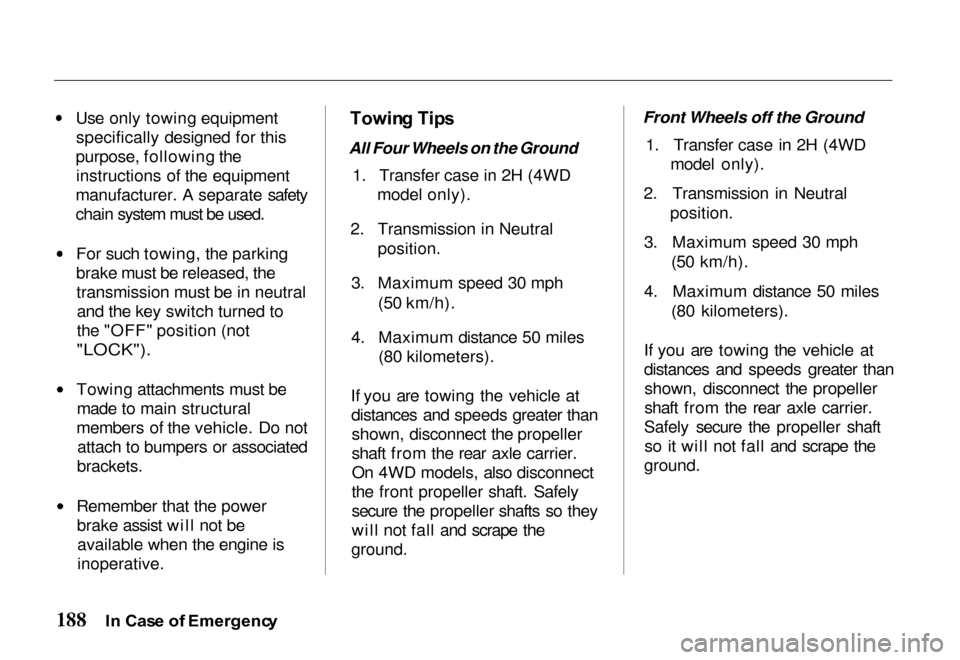
Use only towing equipment
specifically designed for this
purpose, following the instructions of the equipment
manufacturer. A separate safety
chain system must be used.
For such towing, the parking
brake must be released, thetransmission must be in neutraland the key switch turned to
the "OFF" position (not
"LOCK").
Towing attachments must be made to main structural
members of the vehicle. Do not attach to bumpers or associated
brackets.
Remember that the power brake assist will not beavailable when the engine is
inoperative.
Towin
g Tip s
All Four Wheels on the Ground
1. Transfer case in 2H (4WD model only).
2. Transmission in Neutral
position.
3. Maximum speed 30 mph (50 km/h).
4. Maximum distance 50 miles (80 kilometers).
If you are towing the vehicle at distances and speeds greater thanshown, disconnect the propeller
shaft from the rear axle carrier.
On 4WD models, also disconnect
the front propeller shaft. Safely
secure the propeller shafts so they
will not fall and scrape the
ground.
Front Wheels off the Ground
1. Transfer case in 2H (4WD model only).
2. Transmission in Neutral position.
3. Maximum speed 30 mph (50 km/h).
4. Maximum distance 50 miles (80 kilometers).
If you are towing the vehicle at
distances and speeds greater than shown, disconnect the propeller
shaft from the rear axle carrier.
Safely secure the propeller shaft so it will not fall and scrape the
ground.
I n Cas e o f Emergenc y
Page 192 of 267
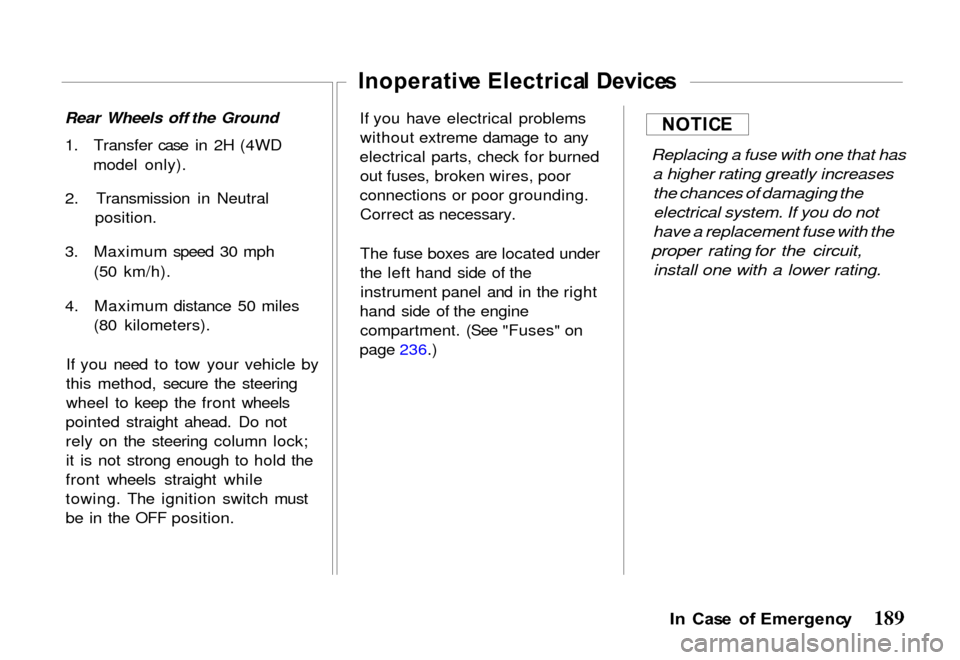
Rear Wheels off the Ground
1. Transfer case in 2H (4WD model only).
2. Transmission in Neutral position.
3. Maximum speed 30 mph (50 km/h).
4. Maximum distance 50 miles (80 kilometers).
If you need to tow your vehicle by
this method, secure the steering
wheel to keep the front wheels
pointed straight ahead. Do not
rely on the steering column lock; it is not strong enough to hold the
front wheels straight while
towing. The ignition switch must
be in the OFF position.
Inoperativ
e Electrica l Device s
If you have electrical problems without extreme damage to any
electrical parts, check for burned out fuses, broken wires, poor
connections or poor grounding. Correct as necessary.
The fuse boxes are located under
the left hand side of theinstrument panel and in the right
hand side of the engine compartment. (See "Fuses" on
page 236.)
Replacing a fuse with one that has
a higher rating greatly increases
the chances of damaging the
electrical system. If you do not
have a replacement fuse with the
proper rating for the circuit,
install one with a lower rating.
In Cas e o f Emergenc y
NOTIC
E
Page 193 of 267

190
Page 194 of 267
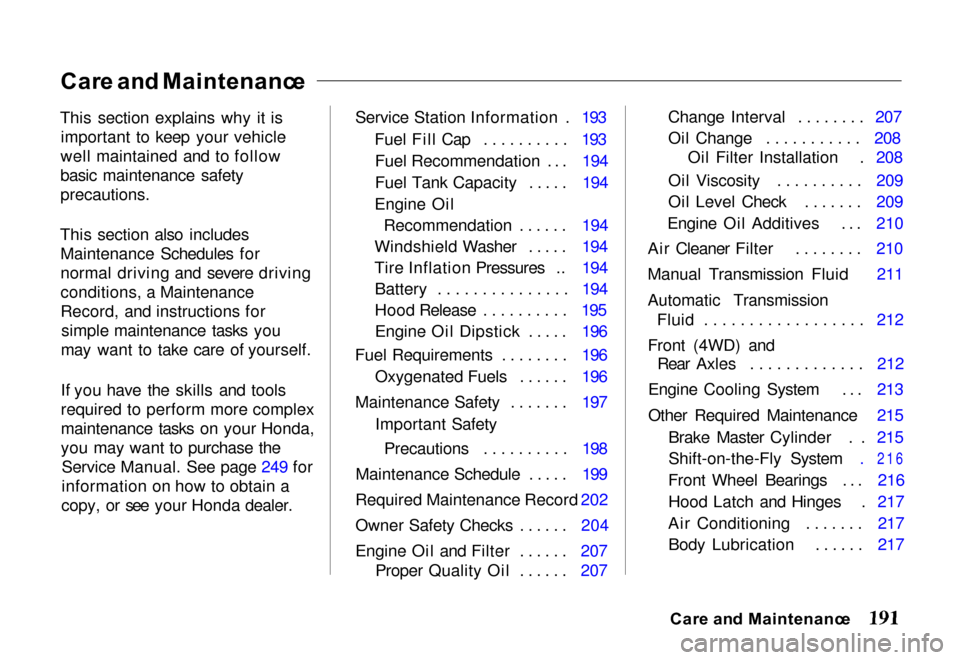
Car
e an d Maintenanc e
This section explains why it is important to keep your vehicle
well maintained and to follow
basic maintenance safety
precautions.
This section also includes Maintenance Schedules for
normal driving and severe driving
conditions, a Maintenance
Record, and instructions for simple maintenance tasks you
may want to take care of yourself.
If you have the skills and tools
required to perform more complex
maintenance tasks on your Honda,
you may want to purchase the Service Manual. See page 249 for
information on how to obtain a
copy, or see your Honda dealer. Service Station Information . 193
Fuel Fill Cap .......... 193Fuel Recommendation ... 194
Fuel Tank Capacity ..... 194
Engine Oil Recommendation ...... 194
Windshield Washer ..... 194
Tire Inflation Pressures .. 194 Battery ............... 194
Hood Release .......... 195
Engine Oil Dipstick ..... 196
Fuel Requirements ........ 196 Oxygenated Fuels ...... 196
Maintenance Safety ....... 197 Important Safety
Precautions .......... 198
Maintenance Schedule ..... 199
Required Maintenance Record 202
Owner Safety Checks ...... 204
Engine Oil and Filter ...... 207 Proper Quality Oil ...... 207 Change Interval ........ 207
Oil
Change ........... 208
Oil Filter Installation . 208
Oil Viscosity .......... 209
Oil Level Check ....... 209
Engine Oil Additives ... 210
Air Cleaner Filter ........ 210
Manual Transmission Fluid 211
Automatic Transmission Fluid .................. 212
Front (4WD) and Rear Axles ............. 212
Engine Cooling System ... 213
Other Required Maintenance 215 Brake Master Cylinder . . 215
Shift-on-the-Fly System
. 216
Front Whee
l Bearings ... 216
Hood Latch and Hinges . 217
Air Conditioning ....... 217 Body Lubrication ...... 217
Car e an d Maintenanc e
Page 195 of 267
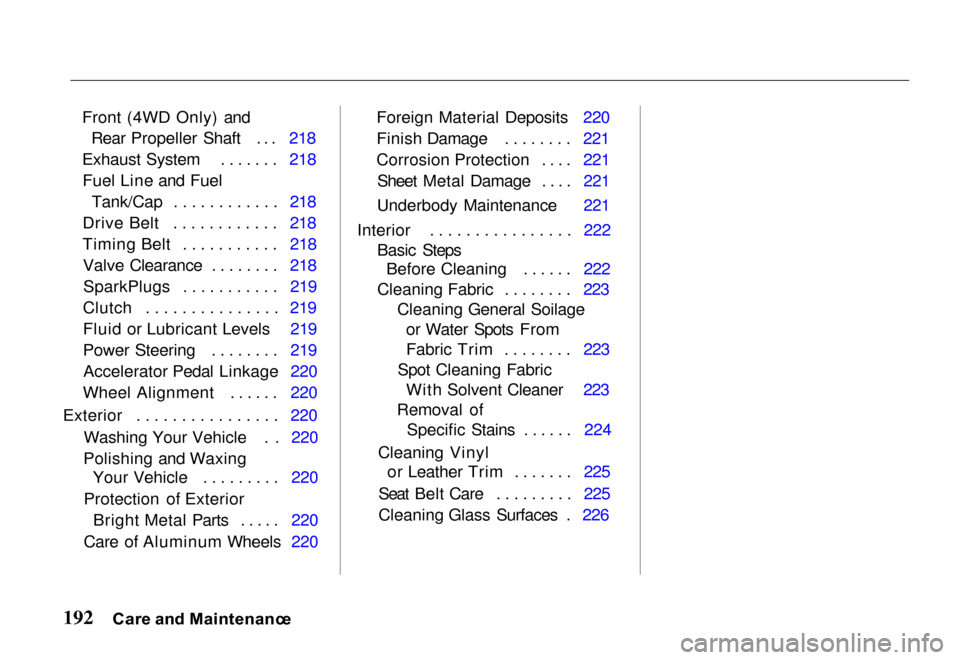
Front (4WD Only) and
Rear Propeller Shaft ... 218
Exhaust System ....... 218 Fuel Line and Fuel Tank/Cap ............ 218
Drive Belt ............ 218
Timing Belt ........... 218 Valve Clearance ........ 218SparkPlugs ........... 219
Clutch ............... 219
Fluid or Lubricant Levels 219
Power Steering ........ 219 Accelerator Pedal Linkage 220
Wheel Alignment ...... 220
Exterior ................ 220 Washing Your Vehicle . . 220
Polishing and Waxing Your Vehicle ......... 220
Protection of Exterior Bright Metal Parts ..... 220
Care of Aluminum Wheels 220 Foreign Material Deposits 220
Finish Damage ........ 221
Corrosion Protection .... 221
Sheet Metal Damage .... 221
Underbody Maintenance 221
Interior ................ 222 Basic StepsBefore Cleaning ...... 222
Cleaning Fabric ........ 223 Cleaning General Soilageor Water Spots From
Fabric Trim ........ 223
Spot Cleaning Fabric With Solvent Cleaner 223
Removal of Specific Stains ...... 224
Cleaning Vinyl or Leather Trim ....... 225
Seat Belt Care ......... 225
Cleaning Glass Surfaces . 226
Car e an d Maintenanc e
Page 196 of 267
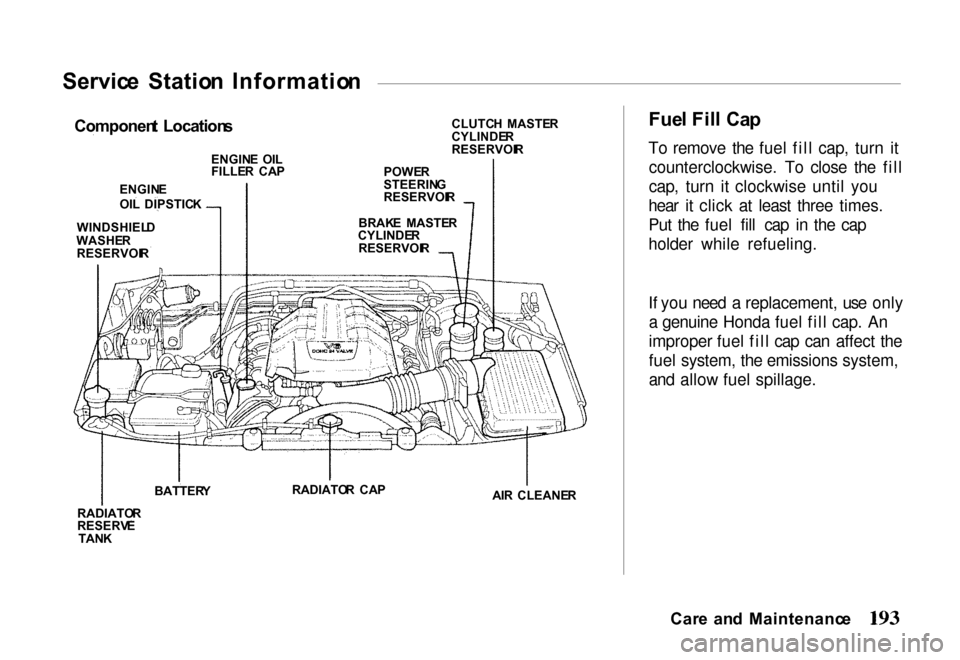
Servic
e Statio n Informatio n
Fuel Fil l Ca p
To remove the fuel fill cap, turn it counterclockwise. To close the fill
cap, turn it clockwise until you
hear it click at least three times.
Put the fuel fill cap in the cap
holder while refueling.
If you need a replacement, use only a genuine Honda fuel fill cap. An
improper fuel fill cap can affect the
fuel system, the emissions system,
and allow fuel spillage.
Car e an d Maintenanc e
Componen t Location s
ENGIN E
OI
L
FILLE R CA P CLUTC
H MASTE R
CYLINDE R
RESERVOI R
POWE R
STEERIN G
RESERVOI R
ENGIN
E
OI L DIPSTIC K
BRAKE MASTE R
CYLINDE R
RESERVOI R
WINDSHIEL
D
WASHE R
RESERVOI R
BATTER Y
RADIATO R
RESERV E
TAN K
RADIATO
R CA P
AIR CLEANE R
Page 197 of 267
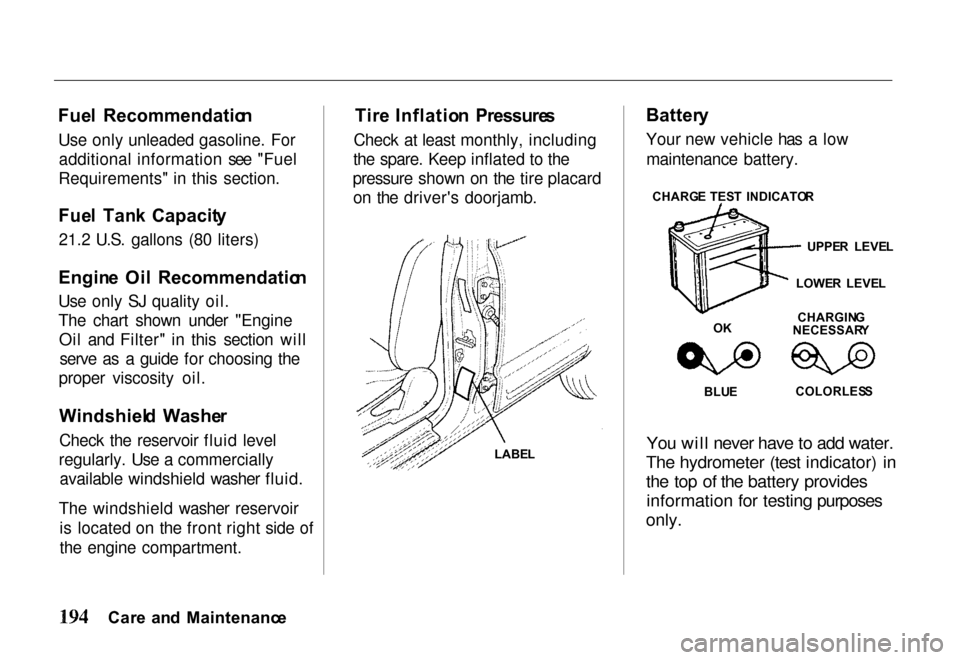
Fue
l Recommendatio n
Use only unleaded gasoline. For additional information see "Fuel
Requirements" in this section.
Fue l Tan k Capacit y
21.2 U.S. gallons (80 liters)
Engin e Oi l Recommendatio n
Use only SJ quality oil.
The chart shown under "Engine Oil and Filter" in this section willserve as a guide for choosing the
proper viscosity oil.
Windshiel d Washe r
Check the reservoir fluid level
regularly. Use a commercially available windshield washer fluid.
The windshield washer reservoir is located on the front right side of
the engine compartment. Tir
e Inflatio n Pressure s
Check at least monthly, including
the spare. Keep inflated to the
pressure shown on the tire placard on the driver's doorjamb. Batter
y
Your new vehicle has a low maintenance battery.
You will never have to add water.
The hydrometer (test indicator) in
the top of the battery provides information for testing purposes
only.
Car e an d Maintenanc e LABE
L CHARG
E TES T INDICATO R
UPPE R LEVE L
LOWE R LEVE L
CHARGIN G
NECESSAR Y
BLU E COLORLES
S
O
K
Page 198 of 267
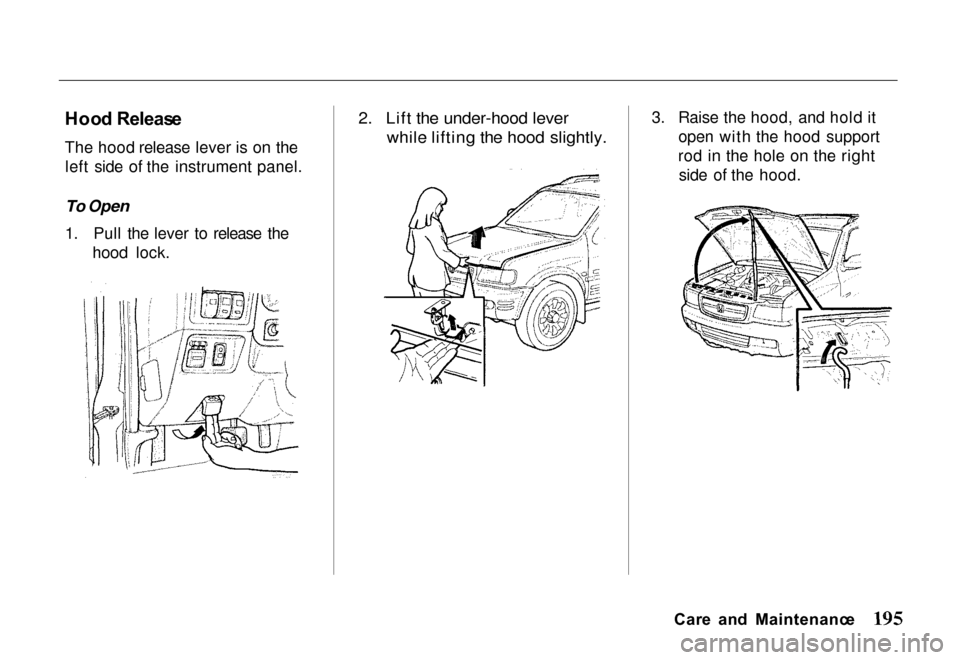
Hoo
d Releas e
The hood release lever is on the left side of the instrument panel.
To Open
1. Pull the lever to release the hood lock.
2. Lift the under-hood lever
while lifting the hood slightly.
3. Raise the hood, and hold it
open with the hood support
rod in the hole on the right side of the hood.
Car e an d Maintenanc e
Page 199 of 267
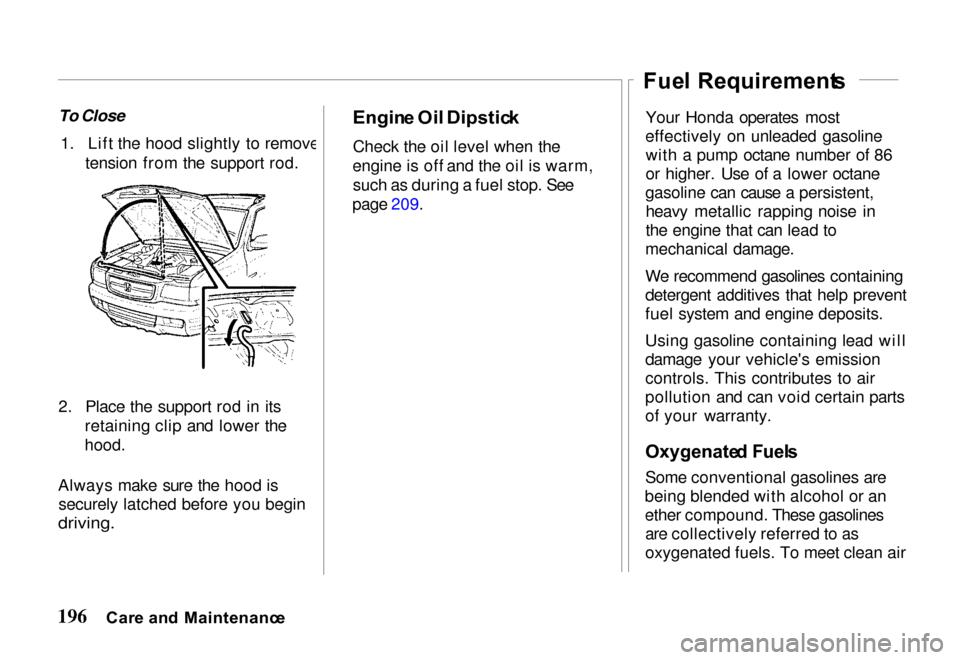
To Close
1. Lift the hood slightly to remove tension from the support rod.
2. Place the support rod in its retaining clip and lower the
hood.
Always make sure the hood is securely latched before you begin
driving.
Engin
e Oi l Dipstic k
Check the oil level when the
engine is off and the oil is warm, such as during a fuel stop. See
page 209. Your Honda operates most
effectively on unleaded gasoline with a pump octane number of 86
or higher. Use of a lower octane
gasoline can cause a persistent, heavy metallic rapping noise in
the engine that can lead to
mechanical damage.
We recommend gasolines containing
detergent additives that help prevent
fuel system and engine deposits.
Using gasoline containing lead will
damage your vehicle's emission
controls. This contributes to air
pollution and can void certain parts
of your warranty.
Oxygenate d Fuel s
Some conventional gasolines are
being blended with alcohol or an
ether compound. These gasolines are collectively referred to as
oxygenated fuels. To meet clean air
Car e an d Maintenanc e
Fue
l Requirement s
Page 200 of 267
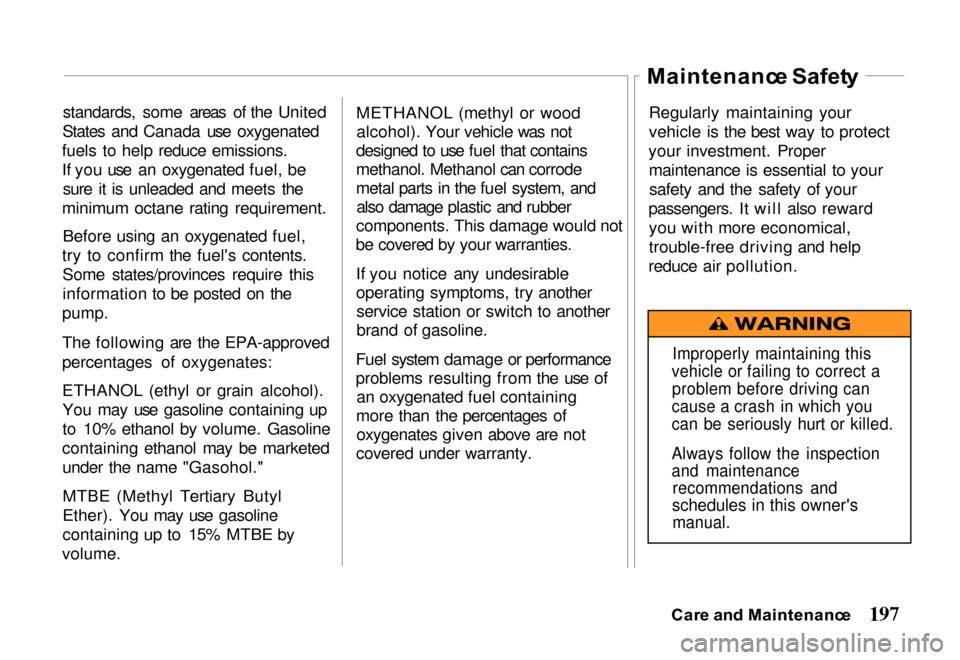
standards, some areas of the United
States and Canada use oxygenated
fuels to help reduce emissions.
If you use an oxygenated fuel, be sure it is unleaded and meets the
minimum octane rating requirement.
Before using an oxygenated fuel,
try to confirm the fuel's contents. Some states/provinces require this
information to be posted on the
pump.
The following are the EPA-approved
percentages of oxygenates:
ETHANOL (ethyl or grain alcohol). You may use gasoline containing up
to 10% ethanol by volume. Gasoline
containing ethanol may be marketed under the name "Gasohol."
MTBE (Methyl Tertiary Butyl
Ether). You may use gasoline
containing up to 15% MTBE by
volume. METHANOL (methyl or wood
alcohol). Your vehicle was not
designed to use fuel that contains
methanol. Methanol can corrode
metal parts in the fuel system, and also damage plastic and rubber
components. This damage woul d not
be covere
d by your warranties.
If you notice any undesirable
operating symptoms, try another service station or switch to another
brand of gasoline.
Fuel system damage or performance
problems resulting from the use of an oxygenated fuel containing
more than the percentages of oxygenates given above are not
covered under warranty. Regularly maintaining your
vehicle is the best way to protect
your investment. Proper maintenance is essential to yoursafety and the safety of your
passengers. It will also reward you with more economical,
trouble-free driving and help
reduce air pollution.
Car e an d Maintenanc e
Maintenanc
e Safet y
Improperly maintaining this
vehicle or failing to correct a problem before driving can
cause a crash in which you
can be seriously hurt or killed.
Always follow the inspection
and maintenance recommendations and
schedules in this owner's
manual.